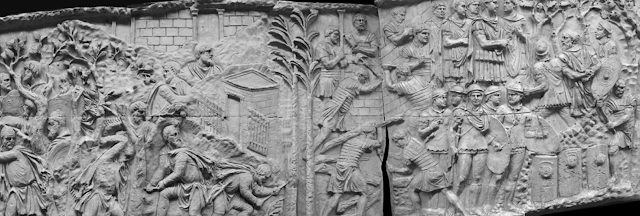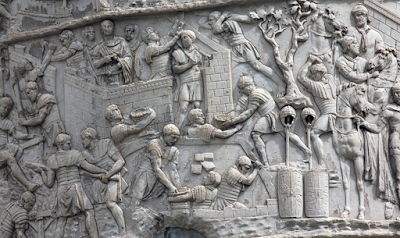 |
| Colosseum |
Romans celebrated civilization and their dominance over the Other in a variety of ways. In previous, posts I have touched on the monumentalization of Rome in sculpture. However, there were other methods in which Romans could perform Romanness—demonstrating the superiority of civilization over the barbarian—in a public setting. The Colosseum, the largest and most famous Roman amphitheatre, was one such place. The Colosseum was built near the end of the first century CE, and it could hold an estimated 65,000 spectators at one time. Roman emperors used these amphitheatres to put on spectacular events that were open to the public as both a display and celebration of Rome's success, and by extension the success of the emperor himself. In short, it was a form of patronage that gave ruling emperors a way to entertain their citizens with the spoils of war. The shows included events such as: gladiatorial combat, animal hunts, executions, and reenactments of past military victories. Another aspect of the games was that they allowed citizens a chance to form a group identity by collectively celebrating the benefits of conquest first hand, as the exotic animals, prisoners, and slaves that took part in the games were often brought to Rome from the provinces for the entertainment of the Roman citizen. The seating at these events was segregated by social class. The slaves were seated furthest away, and more influential citizens were allowed to sit closer to the arena in the centre. The emperor had his own box to further separate him from the masses of citizens. However, I do not believe that it was the slaves who were at the bottom of the hierarchical pyramid because the hierarchy extended past the seating of the amphitheatre to the arena itself. Therefore, it was actually the participants in the arena who were at the bottom of the hierarchy. With the exception of gladiators who were often Roman, the animals and people who were put on display in the arena originated from the provinces and unconquered lands. Therefore, the Otherness of newly conquered provinces was represented by the slaves and captured animals that were forced to fight in the arena, and these provinces were clearly defined as separate and lesser. This public display of provincial Otherness bears striking similarities to the British display of indigenous African and American people in zoos and exhibits during the early modern and modern periods.
The Roman Empire shared many practices of performing civilization and the formation of a group identity in opposition to a barbaric or savage Other with the empires of the early modern period. While they are not identical to the more modern colonial empires, many of the tools that postcolonial theorists have provided for the practice of modern history are, at least to some degree, applicable to the study of the Roman Empire. The practices involved in the domination and exploitation of colonial provinces, as well as the attempted assimilation of colonized peoples are similar in all empires. Rome was no different from the rest.
Johns, Catherine. "Art, Romanisation, and Competence." in Roman Imperialism and Provincial Art. Edited by Sarah Scott, and Jane Webster. New York: Cambridge University Press, 2003.
Kellum, Barbara. "Imperial Messages" in The Oxford Handbook of Roman Sculpture. Edited by Elise A. Friedland, Melanie Grunow Sobocinski, and Elaine K, Gazda. Oxford: Oxford University Press, 2015.
Mattingly, David J. Imperialism, Power, and Identity: Experiencing the Roman Empire. Princeton: Princeton University Press, 2011.













